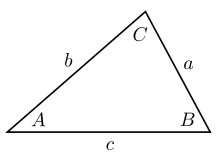Weitzenböck's inequality
In mathematics, Weitzenböck's inequality, named after Roland Weitzenböck, states that for a triangle of side lengths  ,
,  ,
,  , and area
, and area  , the following inequality holds:
, the following inequality holds:
Equality occurs if and only if the triangle is equilateral. Pedoe's inequality is a generalization of Weitzenböck's inequality.
Proofs
The proof of this inequality was set as a question in the International Mathematical Olympiad of 1961. Even so, the result is not too difficult to derive using Heron's formula for the area of a triangle:
First method
This method assumes no knowledge of inequalities except that all squares are nonnegative.
and the result follows immediately by taking the positive square root of both sides. From the first inequality we can also see that equality occurs only when  and the triangle is equilateral.
and the triangle is equilateral.
Second method
This proof assumes knowledge of the rearrangement inequality and the arithmetic-geometric mean inequality.
As we have used the rearrangement inequality and the arithmetic-geometric mean inequality, equality only occurs when  and the triangle is equilateral.
and the triangle is equilateral.
Third method
It can be shown that the area of the inner Napoleon's triangle, which must be nonnegative, is:
so the expression in parentheses must be greater than or equal to 0.
References & further reading
- Claudi Alsina, Roger B. Nelsen: Charming Proofs: A Journey Into Elegant Mathematics. MAA 2010, ISBN 9780883853481, pp. 96-98 (excerpt (Google), p. 96, at Google Books)
- D. M. Batinetu-Giurgiu, Nicusor Minculete, Nevulai Stanciu: Some geometric inequalities of Ionescu-Weitzebböck type. International Journal of Geometry, Vol. 2 (2013), No. 1, April
- Claudi Alsina, Roger B. Nelsen: Geometric Proofs of the Weitzenböck and Hadwiger-Finsler Inequalities. Mathematics Magazine, Vol. 81, No. 3 (Jun., 2008), pp. 216-219 (JSTOR)
External links
- Weisstein, Eric W., "Weitzenböck's Inequality", MathWorld.
- "Weitzenböck's Inequality," an interactive demonstration by Jay Warendorff - Wolfram Demonstrations Project.





